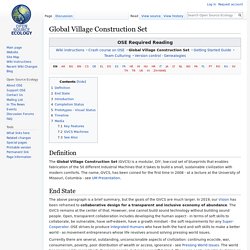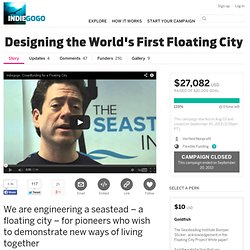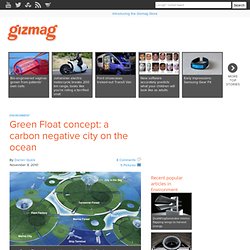

BuildTheEnterprise. Global Village Construction Set. Definition[edit] The Global Village Construction Set (GVCS) is a modular, DIY, low-cost, high-performance platform that enables fabrication of the 50 different Industrial Machines that it takes to build a small, sustainable civilization with modern comforts.

The name, GVCS, has been coined for the first time in 2008 - at a lecture at the University of Missouri, Columbia - see UM Presentation. Media[edit] Key Features[edit] GVCS Machines[edit] See main article GVCS Machine OSE is developing 50 machines of the Global Village Construction Set via module-based design. The exact list of GVCS machines has evolved over time and is still subject to change.
Documentation is found at different places for different target groups: See Also[edit] Arcology Now! Launches Competition for Large-Scale 3D Printed Habitats. “We are practical futurists” — Brian Korsedal, CEO of Arcology Now!

Arcology Now! Inc. is opening it’s revolutionary structure printing technology to the public, and hosting a design competition so that anyone can experience and contribute to the future of building. The company is looking for submissions in the form of 3D models that will be compiled into structures. The winning model will be built full scale in the front yard of their office, with approximate dimensions of 30 ft by 30 ft by 15 ft tall.
This is the first chance for the public to have access to any technology which can digitally design objects of this size and complexity. Details on the design challenge are located at: Designing the World's First Floating City. UPDATE JAN. 2014 Thank you to everyone who supported this effort!

DeltaSync completed the final concept report in December of 2013, and it is now available for download on our website. We hope you enjoy reading it, and welcome your feedback at info@seasteading.org. We also encourage you to take our survey at floating-city.org if you would want to live on the first seastead.
The Carl Sagan Portal. Lilypad floating city concept - Image 1 of 10. The Lilypad floating city concept is designed to house climate change refugees Image Gallery (10 images) With global sea levels predicted to rise significantly over the next century due to climate change, a lot of people living in low lying areas are expected to be displaced from their homes.

Architect Vincent Callebaut has come up with a possible relocation destination for these climate change refugees in the form of the “Lilypad” concept – a completely self-sufficient floating city that would accommodate up to 50,000. View all With a shape inspired by the highly ribbed leaf of Victoria water lilies, the double skin of the floating “ecopolis” would be made of polyester fibers covered by a layer of titanium dioxide (TiO2), which would react with ultraviolet rays and absorb atmospheric pollution via a photocatalytic effect in the same way as the air-purifying concrete and paving stones we looked at last year. Via freshome. Green Float concept: a carbon negative city on the ocean. The idea of going offshore to satisfy our renewable energy needs isn't new, but the grand vision of Japan’s Shimizu Corporation goes way beyond harnessing green energy at sea for use in cities on Terra firma – it takes the whole city along for the ride.

The company, along with the Super Collaborative Graduate School and Nomura Securities, is researching the technical issues involved in constructing its Green Float concept – a self-sufficient, carbon-negative floating city that would reside in the Equatorial Pacific Ocean. View all The concept would comprise individual floating cells or districts resembling water lilies with a radius of 1km (0.62 miles) that would form a compact village that could house 10,000 to 50,000 people. Joining these districts together would form a city or module that would be home to 100,000 people, while a group of modules would form a country (though we assume there is some red tape involved before you get a seat at the U.N.). An Optimistic History of the Next 40 Years. Technology - Tomorrow’s world: A guide to the next 150 years. HowStuffWorks - Learn How Everything Works!
Drake Vs Fermi... The Future. The Planetary Society. NSRC 2012. Clarke's three laws. Clarke's Three Laws are three "laws" of prediction formulated by the British science fiction writer Arthur C.

Clarke. They are: When a distinguished but elderly scientist states that something is possible, he is almost certainly right. When he states that something is impossible, he is very probably wrong.The only way of discovering the limits of the possible is to venture a little way past them into the impossible.Any sufficiently advanced technology is indistinguishable from magic. Origins[edit] Clarke's First Law was proposed by Arthur C. The second law is offered as a simple observation in the same essay. The Third Law is the best known and most widely cited, and appears in Clarke's 1973 revision of "Hazards of Prophecy: The Failure of Imagination". A fourth law has been added to the canon, despite Sir Arthur Clarke's declared intention of not going one better than Sir Isaac Newton.